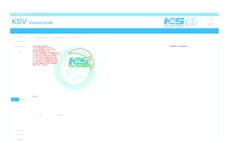Automated Inspection System Added to Bottle Cap Manufacturing Process
A German bottle cap manufacturer has added a machine vision-based automated inspection system to check for print and quality errors on beverage bottle caps made for beer breweries.
Each bottle cap is made of ceramic and is attached to a stopper that inserts into the neck of the bottle. The cap and stopper are held in place by an apparatus that includes a small bar that lays across the top of the cap and is attached to a hinged gasket. When the bar is flipped up, the gasket pulls the cap and stopper out of the neck, opening the bottle.
Traditionally, inspection of the bottle caps was performed by human inspectors, who manually inspected them for any flaws, either in the bottle cap materials or with the printing on the top of the cap. However, because the manufacturing process is automated, manual inspection is less efficient and more error prone.
So, the challenge was to develop an inspection system that not only can handle quality control requirements at the speed the production process requires but is easily operated, maintained, and simple to reconfigure and change, says Thomas Kelz, who is responsible for quality technology at K&S Anlagenbau GMBH (Lengenwang, Germany), the automation solutions company that developed the inspection system.
“Our aim is to make automated processes as safe and as reliable as possible,” says Kelz. “Our approach is to take the ‘hectic’ out of production processes.”
See Related Content: Titan Cement Adds Inspection System to Production Facility
Integrating a Machine Vision-Based Inspection System into the Production Process
The inspection system is one application within the bottle cap manufacturing process. The machine vision processes in the system, such as the inspection system, is controlled by a PC onsite that has a graphical user interface capable of running multiple applications simultaneously. To communicate easily with other components in the system, the machine vision software has interfaces for OPC Unified Architecture, a cross-platform, open-source standard for data exchange from sensors to cloud applications, and Profinet, a technical standard for data communication over industrial ethernet, which is especially designed for fast data delivery under tight time constraints. These interfaces allow consistent data exchange between the various components in the manufacturing process.
The bottle caps move through the production process via a conveyor system. Six Basler ACA2040-35GC cameras equipped with Basler ACC-LEN-200003567 lenses, and one Basler CXP-12 EVAL BOA4096-93 camera equipped with an Opto Engineering PCCDO23 lens, are deployed along the line and connected, via ethernet cables, to a Spectra (Reutlingen, Germany) industrial PC. the inspection system checks each bottle cap for correct shape, flaws in the ceramic top and stopper cork materials, and ensures the printing on the top of each cap is correct.
“There are several cameras connected to this computer vision system and each camera is basically performing its own inspection tasks,” notes Markus Heber, software integrator and general manager of Computer Vision Solutions (Langenzersdorf, Austria), who worked with K&S Anlagenbau to develop this inspection system. While the team used Basler cameras for this project, the system can work with any camera that has GigE Vision or GenICam interfaces, he says.
“The entire system is automated,” Heber says. “If it says the bottle cap is OK, then it continues in the production process. If it is not OK, then it is immediately redirected to another area, where a human worker will follow up.”
The PC is equipped with software, developed and written in-house by K&S Anlagenbau, that controls the inspection system. For the machine vision applications involved, Heber integrated MVTec (Munich, Germany) Halcon machine vision software into the control software using MVTec’s HDevEngine, a machine vision library that acts as an interpreter to load and execute the machine vision algorithms, Heber says.
”It acts as the image processing backend and communicates with the GUI in the background,” Heber says.
How the Inspection System Works
The inspection system uses matching, classification, and blob analysis technologies to perform the inspection analysis tasks. First, a camera captures an image of a bottle cap and transmits it to the computer. The computer, using the Halcon software, utilizes shape-based matching technology, which uses a pre-trained matching image—in this case, an image of a perfectly manufactured and printed bottlecap — to compare to the image captured by the camera. The pre-trained image is matched with the image captured by the inspection camera, allowing the position and alignment to be determined with sub-pixel accuracy, Heber says. “This works even if the image is rotated, scaled, distorted, partially covered, or subject to non-linear lighting fluctuations,” he says.
The system then uses classification technology to look for errors in the image being inspected. Such flaws and errors can include color deviations, missing or incorrect edges, and/or flawed structures. Corresponding deviations are segmented and analyzed using blob analysis technology, which essentially is an analysis of consistent image regions, known as blobs. In this case, the blobs are connected pixels with similar brightness, Heber says.
If the system detects a defect, it displays the image in the GUI, highlighting that defect in color. This allows anyone monitoring the system to recognize the type and extent of the defect. For example, “if a bottle cap is not printed correctly, the HALCON software informs the system accordingly and the component is automatically ejected," Dr. Heber explains.
The system does not store images of the inspected items, Heber says. If the bottle cap passes inspection, the image captured for inspection by the system is deleted. If an error or defect is detected, the image is saved until the issue is resolved, then deleted.
See Related Content: Federal package Uses Smart Camera System to Inspect Deodorant Products
Results
“The feedback we have received has been very positive,” Heber says. Indeed, Heber and Kelz say the system can inspect 120 bottle caps per minute and has operated without any major issues since it was implemented in the bottle cap production facility two years ago.
The system is designed to be versatile and easily adaptable; Heber says he is working with K&S Anlagenbau on possible 3D applications for this system.
See Related Content: How the Pandemic Impacted F&B's Interest in Automation
About the Author
Jim Tatum
Senior Editor
VSD Senior Editor Jim Tatum has more than 25 years experience in print and digital journalism, covering business/industry/economic development issues, regional and local government/regulatory issues, and more. In 2019, he transitioned from newspapers to business media full time, joining VSD in 2023.




